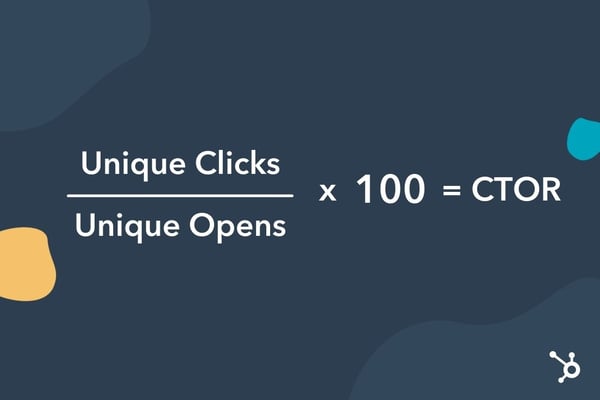Ever since email marketing became a legitimate marketing channel in the 1990s, email marketers have largely measured their performance against two metrics: open rate and clickthrough rate.
The open rate measures the percentage of recipients who opened your email, which helps you gauge the performance of your subject line and preview. Your clickthrough rate (CTR) measures the percentage of recipients who clicked on the links in your email against the total number of subscribers who received the email.
This means that a low open rate can dilute your clickthrough rate, even if a large percentage of the recipients who opened your email clicked through to your website. With this in mind, your clickthrough rate may not be the best indicator of engagement.
So, how do you accurately measure your email campaigns’ true levels of engagement? Cue the click-to-open rate, or CTOR.
At HubSpot, our email marketing team measures their campaigns’ engagement against CTOR because it’s a clear indicator of resonance.
“CTOR helps us understand and measure how our email message and CTAs are resonating and performing with our audience,” says Ari Echt-Wilson, a Conversational Marketing Manager at HubSpot and former Experiment Head of HubSpot’s Global Messaging Team. “Since the only people who see the message are the ones that open the email, it makes sense for us to measure clicks based on those who opened the email.”
How To Calculate the CTOR
To calculate the click-to-open rate, the formula is simple: You start by dividing the number of unique clicks by the number of unique opens. Then, you multiply that number by 100. The answer is your CTOR.

Let’s use an example: You send an email to 1,000 subscribers. Twenty subscribers open the email and there are a total of 15 clicks. Here’s how you find the CTOR: (15/20) x 100 = 75%. This would mean that your CTOR is very high, with the majority of subscribers who opened the email clicking on the links.
When using this formula, it’s important to only count unique opens and clicks. For instance, if one of your subscribers opens your email in the morning and clicks on a link. Then, later that night, they go back to the email and click on it again. You wouldn’t want that subscriber to be counted twice, as that would muddle the data. That’s why the CTOR must only account for unique opens and clicks.
Now that you know how to calculate the CTOR, you may want to set benchmarks for your own emails. A 2020 Campaign Monitor report found that the average click-to-open rate across all industries is 14.3%. Brands in real estate, design, and construction industries see the highest CTOR averages at 17.7%. The same report shows that food and beverage brands experience the lowest CTOR at 8.9%.
Use these numbers as benchmarks for your own campaigns.
CTR vs. CTOR: Which one is better?
According to Echt-Wilson, CTOR is arguably the best metric for measuring an email campaign’s resonance. But this rate can reveal even more insights about your email marketing, helping your team understand how to improve your campaigns.
“If an email is never opened, then it’s hard to grasp how we can move the needle in terms of engagement,” says Tova Miller, a Senior Marketing Manager and former Demand Generation Marketing Manager at HubSpot.
Clickthrough rate is still a valuable metric to track though, especially when you need a holistic view of your email’s performance.
“I look at clickthrough rate to get a high-level understanding of how my email performed overall,” says Jordan Pritikin, the Email and Growth Marketing Manager at HubSpot. “Since CTR accounts for deliverability, subject line performance, and how your email’s content performed, it’s a good metric to look at when I need a quick glance at how my email performed overall.”
How to Improve Your CTOR
Whether you’ve been tracking your CTOR for a while or plan to start, there will always be room for improvement. Here are a few steps to take to enhance your CTOR:
1. Use CTA buttons.
A great email has a few elements: engaging copy, enticing images, and compelling calls-to-action. And in an email full of text, button CTAs are great attention-catchers.
You can use text-based CTAs, like “Click here for more information.” However, some data reports suggest that buttons can lead to higher clickthrough rates. In one A/B test, Campaign Monitor saw a 28% increase in conversions by using a button instead of a text link.
Here are a few tips to keep in mind when using buttons:
Keep the prompt short: one to three words.
Use action-based verbs, like “learn,” “discover,” “find,” and “start.”
Place your CTA after presenting the offer, not before.
Lastly, your CTA button should be prominent enough to stand out, but not so big that it hinders the overall user experience. If you’re not sure, do a squint test to make sure it’s just right.
2. Re-evaluate your offers.
One of the reasons why your click-to-open rate may be low is because your offers don’t align with your audience’s interests. You may find that subscribers are opening up your email but as they scroll, none of the links appeal to them.
There are a few ways to address this:
Segment your email list – This will ensure you deliver emails that your subscribers are actually interested in. Your leads shouldn’t be receiving the same emails as your customers. They’re in different stages of the funnel and may have different motivations.
Send a survey – If you’re not sure what offers your audience want to see, who better to ask than the source itself? You can also include link triggers in the email survey that can segment subscribers based on their answers.
3. Stick to one CTA.
There are a few tactics you can use when it comes to email CTAs. Some brands prefer to employ multiple CTAs in their emails, leaving it up to subscribers to click on the one they find most interesting. You’ll see this often in emails for retail offers. The idea is that more CTAs equals more opportunities to increase CTR.
One drawback of this approach is choice overload. It happens when consumers have difficulty making a decision because they are faced with too many options.
With this in mind, consider testing a single CTA. If there’s only one desired action, you may increase your CTOR by using this focused method.
However, keep in mind that this approach may not be appropriate for all campaigns. Experiment, A/B test, and adjust as needed.
Email Marketing Is Always Adapting
Email marketing might be one of the most established marketing channels in the digital era, but it’s always adapting. Clickthrough rate reigned as the superior engagement metric for most of email marketing’s history, but the click-to-open rate is proving to be a lot more revealing and insightful than its predecessor.
![]()
Read more: blog.hubspot.com


